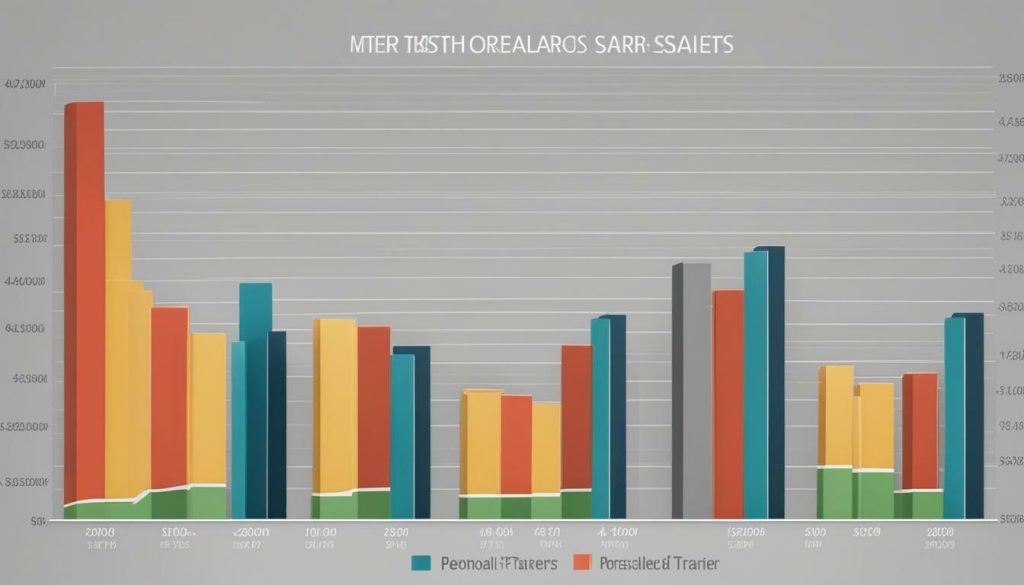
At Fitness & Form, we offer comprehensive personal trainer skill development programs to help you uncover your potential and excel in your coaching career. Our programs focus on enhancing your coaching techniques, business management skills, and client assessment abilities. We understand the importance of equipping personal trainers with the necessary tools and knowledge to thrive in the health and fitness industry.
Key Takeaways:
- Personal training forms such as PAR-Q, waiver of liability, client agreement/contract, and medical history are crucial for smooth operations and client management.
- Client assessment and goal setting play a vital role in designing tailored workout regimens to help individuals achieve their desired fitness goals.
- Developing essential skills such as leadership, communication, customer service, and problem-solving are key for personal trainers to effectively guide and support their clients.
- Completing a certification course and acquiring knowledge in fitness and nutrition are important steps to becoming a certified personal trainer.
- Personal trainers have various career opportunities, including working in gyms, recreation centers, schools, government facilities, and offering in-home training sessions.
Remember to maintain a conversational and informative tone throughout the article.
Essential Personal Training Forms
Personal trainers must be familiar with a range of essential personal training forms, including PAR-Q, waiver of liability, client agreement/contract, fitness assessment, medical history, goal-setting form, fitness assessment informed consent, client referrals, and privacy policy. These forms are crucial for efficient client management and smooth operations.
The Physical Activity Readiness Questionnaire (PAR-Q) is a standard form used by personal trainers to assess clients’ readiness for physical activity and identify any potential health risks. It helps trainers understand if any modifications or precautions need to be taken in designing workout programs.
The waiver of liability form is necessary to protect personal trainers and their businesses from potential legal claims arising from injuries or accidents during training sessions. This form ensures that clients understand and accept the risks associated with physical activity.
The client agreement/contract form outlines the terms and conditions of the training program, including session fees, cancellation policies, and liability waivers. Having a clear agreement in place helps establish expectations and protects both the trainer and the client.

| Form | Purpose |
|---|---|
| PAR-Q | To assess clients’ readiness for physical activity and identify health risks. |
| Waiver of Liability | To protect trainers and their businesses from legal claims related to injuries or accidents during training sessions. |
| Client Agreement/Contract | To outline the terms and conditions of the training program, including fees, cancellation policies, and liability waivers. |
“Personal training forms play a crucial role in client management and operational efficiency. They ensure that trainers have the necessary information to design safe and effective workout programs, while also protecting their business interests. By utilizing these forms, personal trainers can maintain professionalism, establish clear expectations, and provide a structured experience for their clients.”
Client Assessment and Goal Setting
A crucial aspect of personal training is assessing clients’ fitness goals, evaluating their current fitness levels, and setting realistic targets to guide them on their fitness journey. By understanding their goals and capabilities, personal trainers can design personalized workout regimens and provide guidance on exercise form, lifestyle choices, and dietary habits. Client assessment and goal setting are fundamental steps in ensuring that clients receive appropriate and effective training plans.
During the initial assessment, personal trainers gather information about the client’s medical history, exercise experience, and any pre-existing conditions or injuries. This information helps trainers determine the client’s current fitness level and identify any limitations or special considerations that need to be taken into account. By conducting thorough assessments, trainers can create tailored programs that address the client’s unique needs and goals.
Goal setting is another vital component of the personal training process. It involves establishing realistic, measurable, and time-bound objectives that align with the client’s desires and abilities. Setting achievable goals helps clients stay motivated and see progress over time. Trainers work closely with clients to define specific targets such as weight loss, muscle gain, increased stamina, or improved functionality. These goals are then broken down into manageable steps, allowing clients to track their progress and make adjustments as needed.
By conducting thorough client assessments and setting realistic goals, personal trainers can provide tailored training programs that maximize results and promote overall health and well-being. Through ongoing monitoring and evaluation, trainers can ensure that clients stay on track, adjust their plans when necessary, and achieve their desired outcomes.
Client Assessment and Goal Setting process
| Step | Description |
|---|---|
| 1 | Gather client information, including medical history, exercise experience, and any pre-existing conditions or injuries. |
| 2 | Assess the client’s current fitness level, considering factors such as strength, flexibility, cardiovascular endurance, and body composition. |
| 3 | Discuss the client’s goals and aspirations, both short-term and long-term. |
| 4 | Collaboratively define realistic, measurable, and time-bound objectives that align with the client’s desires and abilities. |
| 5 | Break down the goals into smaller, actionable steps to track progress and make adjustments as needed. |
| 6 | Regularly monitor and evaluate the client’s progress, providing support, motivation, and guidance along the way. |
“Setting goals is the first step in turning the invisible into the visible.” — Tony Robbins

By engaging in thorough client assessment and goal setting, personal trainers can effectively guide their clients towards achieving their fitness aspirations. These essential steps lay the foundation for successful personal training and help trainers create customized workout plans that bring clients closer to realizing their full potential.
Essential Skills for Personal Trainers
To be a successful personal trainer, it is essential to develop key skills such as leadership, communication, customer service, and problem-solving to provide effective guidance and support to clients. These skills go hand in hand with the technical knowledge and expertise required to design customized workout programs and promote healthy lifestyle habits. As a personal trainer, I understand the importance of continuously honing these essential skills to deliver exceptional results.
Leadership is a crucial skill that allows personal trainers to inspire and motivate clients to reach their fitness goals. By setting a positive example, demonstrating proper exercise form, and providing encouragement, trainers can instill a sense of confidence and accountability in their clients. I personally strive to lead by example in every session, pushing my clients to exceed their own expectations and discover their full potential.
Effective communication is another vital skill that personal trainers must possess. Clear and concise communication helps trainers explain complex exercises, demonstrate proper techniques, and ensure that clients understand the importance of maintaining proper form to prevent injuries. Good communication also extends to listening attentively to clients’ concerns, goals, and limitations, allowing trainers to tailor workout programs that address their unique needs and preferences.
Quote: “The difference between good trainers and great trainers lies in their ability to provide exceptional customer service. As a personal trainer, I prioritize building strong relationships with my clients, understanding their individual personalities, and fostering a supportive and inclusive environment for all. Going above and beyond for my clients is not just a job requirement; it is a personal commitment that I take pride in.” – [Your Name]
Problem-solving is yet another skill that personal trainers must possess to adapt to unexpected challenges or changes during training sessions. Whether it’s modifying exercises for clients with injuries, creating alternative workout plans for those with limited equipment, or finding solutions to overcome plateaus, problem-solving skills enable trainers to provide effective solutions and keep clients motivated on their fitness journey.
| Leadership | Communication | Customer Service | Problem-Solving |
|---|---|---|---|
| Lead by example | Clear and concise communication | Build strong relationships | Adapt to unexpected challenges |
| Inspire and motivate | Listen attentively | Provide exceptional service | Modify exercises and plans |
| Instill confidence and accountability | Demonstrate proper techniques | Foster a supportive environment | Overcome plateaus |

To summarize, personal trainers play a vital role in helping individuals achieve their fitness goals. Alongside technical expertise, developing essential skills such as leadership, communication, customer service, and problem-solving is crucial for success in this field. By continuously improving these skills, personal trainers can provide superior guidance and support to clients, ultimately leading them towards a healthier and happier lifestyle.
Certification and Education
Achieving certification and acquiring knowledge in fitness and nutrition are vital steps in the journey to becoming a professional personal trainer. Fitness & Form offers comprehensive certification courses that cover all aspects of personal training, from exercise science to client assessment and program design. The courses are designed to equip aspiring trainers with the skills and knowledge needed to excel in the industry.
During the certification process, trainers learn about anatomy and physiology, exercise techniques, injury prevention, and nutrition principles. They also gain practical experience through hands-on training and workshops. Fitness & Form’s certification programs are recognized and respected in the industry, providing trainers with a competitive edge in the job market.
Upon completion of the certification course, trainers receive a recognized credential that demonstrates their expertise and commitment to professional development. This certification not only enhances their credibility but also opens doors to various career opportunities in gyms, fitness centers, and other fitness-related establishments.
Continued education is also essential for personal trainers to stay up to date with the latest trends and research in the field. Fitness & Form offers ongoing educational programs, workshops, and conferences that allow trainers to expand their knowledge and skills. By investing in their education, trainers can provide the highest level of service to their clients and continuously grow in their careers.

| Benefits | Description |
|---|---|
| Enhanced Credibility | Certification demonstrates expertise and commitment to professional development, boosting credibility in the industry. |
| Competitive Edge | A recognized certification gives trainers a competitive advantage in the job market, increasing employment opportunities. |
| Expanded Knowledge | Ongoing education allows trainers to stay informed about the latest research and trends, improving the quality of their services. |
| Networking Opportunities | Workshops and conferences provide trainers with the chance to connect with industry professionals and expand their professional network. |
Career Opportunities for Personal Trainers
Personal trainers have a wide range of career opportunities, including working in gyms, recreation centers, schools, government facilities, and providing personalized in-home training sessions. These diverse settings offer personal trainers the chance to work with different populations and help individuals achieve their fitness goals.
Working in a gym provides personal trainers with a supportive environment where they can interact with a variety of clients. They have access to state-of-the-art equipment and can offer group fitness classes to engage with multiple individuals at once. Recreation centers, on the other hand, allow personal trainers to work in a more community-focused setting, promoting health and wellness within the local area.
Schools and government facilities offer unique opportunities for personal trainers to make a difference in the lives of young people and public employees. By providing fitness education and training, personal trainers can contribute to the overall well-being of students and government staff members.
| Types of Career Opportunities | Description |
|---|---|
| Gyms | Offering one-on-one training sessions, group classes, and access to fitness equipment. |
| Recreation Centers | Providing fitness programs and services to the local community. |
| Schools | Teaching physical education classes and promoting healthy lifestyles among students. |
| Government Facilities | Assisting public employees in improving their fitness levels and overall well-being. |
Additionally, personal trainers have the opportunity to offer personalized in-home training sessions. This allows them to work closely with clients in a comfortable and convenient setting, tailoring workouts to individual needs and goals. In-home training provides a more intimate and personalized experience, fostering a strong client-trainer relationship.

Diversifying one’s career as a personal trainer not only expands professional horizons but also allows for personal growth and development. Whether in a gym, recreation center, school, government facility, or home setting, personal trainers have the power to positively impact the lives of others through their expertise and guidance.
Salary and Job Outlook
The median annual salary for fitness trainers is $40,700, with a projected job outlook of 19% growth between 2021 and 2031, making it an enticing career choice for aspiring personal trainers. With a passion for health and fitness, individuals can turn their love for exercise into a rewarding profession.
Becoming a personal trainer offers not only the opportunity to help others achieve their fitness goals but also the potential for a stable and lucrative career. The fitness industry is experiencing rapid growth, driven by an increased focus on health and wellness. As more people recognize the importance of regular exercise and seek professional guidance, the demand for personal trainers continues to rise.
Personal trainers can work in various settings, including gyms, recreation centers, schools, government facilities, and even provide in-home training sessions. This flexibility allows trainers to choose an environment that aligns with their personal preferences and goals. Whether it’s managing a team of trainers in a fitness facility or working one-on-one with clients in their homes, personal trainers have the freedom to tailor their career to their liking.
| Work Setting | Median Annual Salary |
|---|---|
| Gyms and Health Clubs | $38,840 |
| Government Facilities | $45,780 |
| Schools and Educational Services | $36,660 |
| Recreation Centers | $37,610 |
| In-home Personal Training | $59,860 |
As the table above demonstrates, personal trainers can earn competitive salaries depending on their chosen work setting. In-home personal training, for example, offers the potential for higher earnings due to the personalized nature of the service. Trainers who establish a strong client base and build a reputation for delivering results can command higher rates.
Furthermore, the projected job outlook for personal trainers is positive, with a 19% growth rate expected between 2021 and 2031. This growth is significantly higher than the average for all occupations, indicating a steady stream of job opportunities for aspiring personal trainers. The increasing emphasis on preventive healthcare and the growing popularity of group fitness classes are contributing factors to the industry’s expansion.

In conclusion, a career as a personal trainer offers not only the potential for a fulfilling and gratifying profession but also the chance to make a positive impact on others’ lives. With a commitment to continuing education and a passion for helping people achieve their fitness goals, personal trainers can thrive in this dynamic field. The combination of a competitive salary and a promising job outlook makes personal training an attractive option for those seeking a career in the health and fitness industry.
The Path to Becoming a Personal Trainer
Becoming a personal trainer requires dedication, hard work, and a genuine passion for health and fitness, but the rewards are endless. As a personal trainer, you will not only help clients achieve their fitness goals but also make a positive impact on their lives.
To start your journey, you need to complete a certification course and acquire knowledge in fitness and nutrition. Certification programs can vary in duration, ranging from a few days to several months, depending on the level of expertise you want to achieve. These courses will equip you with the necessary skills and knowledge to guide clients effectively.
Personal trainers play a crucial role in assessing clients’ fitness goals and designing tailored workout regimens. You will evaluate clients’ current fitness levels, consider their medical history, and set realistic goals to help them achieve the desired results. Additionally, you will provide guidance on exercise form, lifestyle choices, and diet habits to ensure overall well-being.
Once you are certified, various career opportunities await you in the fitness industry. You can work in gyms, recreation centers, schools, government facilities, or even provide in-home training sessions. The median annual salary for fitness trainers is $40,700, and the job outlook is projected to grow by 19% between 2021 and 2031, indicating a promising future for personal trainers.
FAQ
What are the essential personal training forms?
The essential personal training forms include PAR-Q, waiver of liability, client agreement/contract, fitness assessment, medical history, goal-setting form, fitness assessment informed consent, client referrals, and privacy policy. These forms are crucial for smooth operations and client management.
What is the role of client assessment and goal setting in personal training?
Personal trainers evaluate clients’ fitness goals, assess their current fitness levels, and design tailored workout regimens to help them achieve their desired results. Setting realistic goals is essential for effective training and progress tracking.
What are the essential skills for personal trainers?
Personal trainers should have skills in leadership, communication, customer service, and problem-solving. These skills are necessary to effectively guide and support clients on their fitness journeys.
How can I become a certified personal trainer?
To become a certified personal trainer, you need to complete a certification course in fitness and nutrition. The duration of certification programs can vary from a few days to several months, depending on the program you choose.
What are the career opportunities for personal trainers?
Personal trainers can work in a variety of settings, including gyms, recreation centers, schools, government facilities, and even provide in-home training sessions. There are ample career opportunities available for personal trainers to explore.
What is the median annual salary for fitness trainers?
The median annual salary for fitness trainers is $40,700. It’s important to note that salaries can vary depending on factors such as location, experience, and clientele.
What is the job outlook for personal trainers?
The job outlook for personal trainers is projected to grow by 19% between 2021 and 2031. This growth indicates an increasing demand for fitness professionals in the industry.
What does it take to become a personal trainer?
Becoming a personal trainer requires dedication, hard work, and a passion for health and fitness. It involves completing a certification course, acquiring knowledge in fitness and nutrition, and continuously enhancing coaching techniques.



